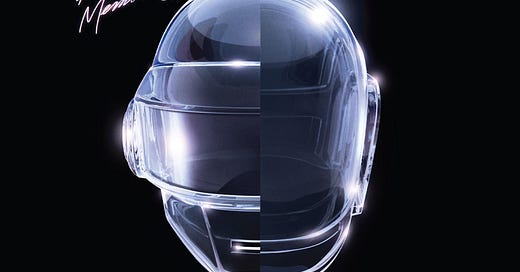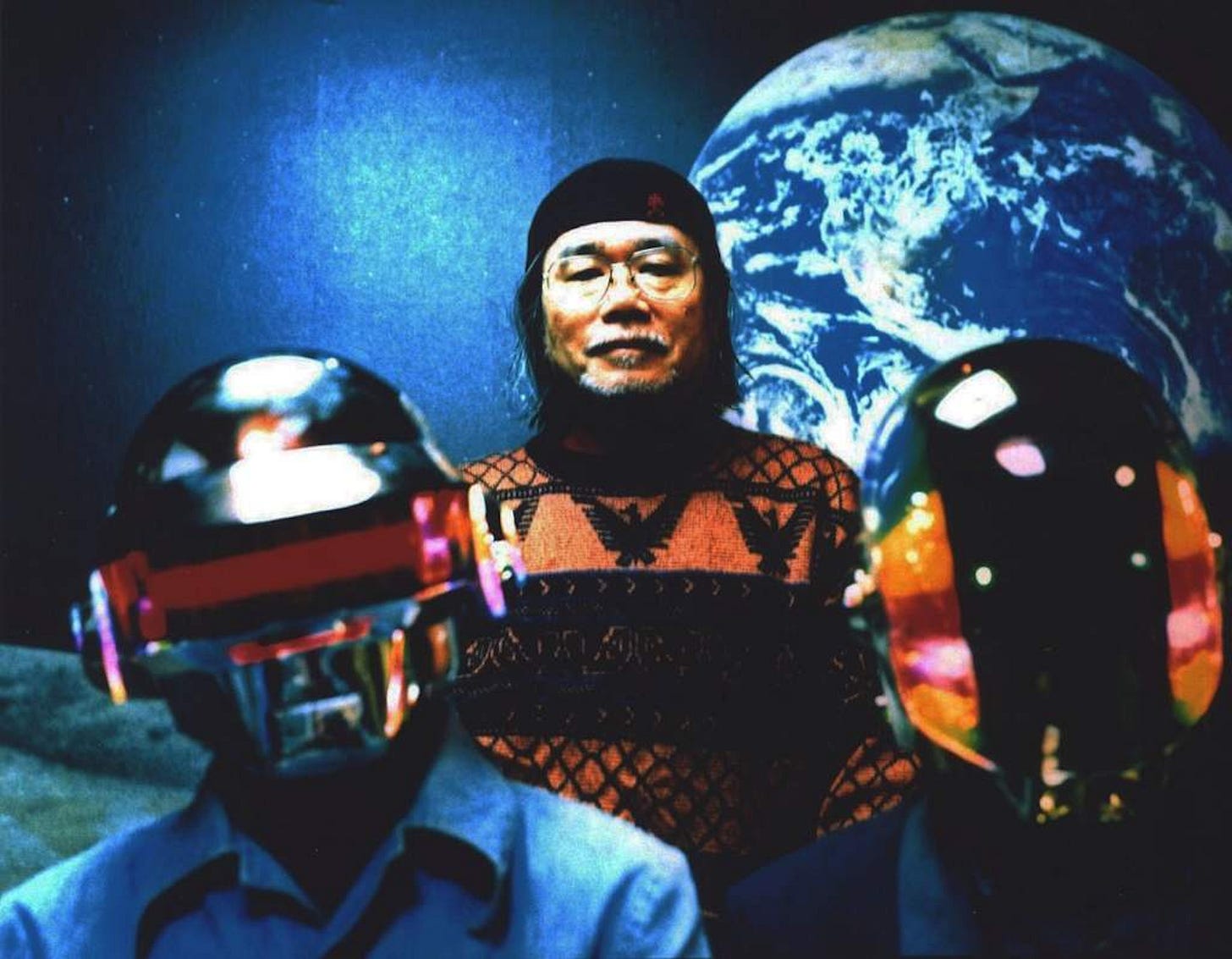The year in both A.D.’s orbit and music at large is undoubtedly stepping up a notch. But I’ll start on a more tender note.
It was a great shame to hear of Leiji Matsumoto’s passing. The fabled mangaka’s work on Interstella 5555 alongside the then-core Daft/Virgin team of Thomas, Guy-Man, Pedro, Gildas, Emmanuel and Cédric — plus the film’s producer, Shinji Shimizu, and director, Kazuhisa Takenouchi — is imprinted in the minds of millions.
It’s hard to quantify how many people in the early 2000s with access to MTV, or even Toonami, will have peripherally absorbed the promo clips for Discovery’s first four singles. And that’s before you get to tallying their fearsome combined play count on YouTube. A true cornerstone of Millennial childhood – they were everywhere.
Interstella 5555’s influence will be given ample inches in After Daft. In many senses, I5555 sparked the A.D. era. If anything, the film stands as curiously underrated today.
It’s a strange feeling to know that A.D. was the final press request Leiji Matsumoto ever dealt with. Our last correspondence with him, through Toei Animation and his family, was on February 8th; he passed of heart failure less than a week later. Our thoughts are with them.
It was a beautiful surprise and a true mark of validation to hear that last year’s long-read on the Teachers of Chicago & Detroit and the connected visual mixtape has been added into King Britt’s Blacktronika course at the University of California, San Diego.
King Britt has been doing sterling work bringing his students the history of Black electronic music, as well as minting a new archive of interviews with Herbie Hancock, Questlove, Jeff Mills, Common, George Clinton, DJ Pierre and more. To be part of that fabric is a treat.
Meanwhile, the entire dance music sphere has been convulsed by a familiar face to those who read the newsletter’s last instalment: Skrillex. His Ocean’s Three-style raid on the public consciousness avec Fred Again and Four Tet is one of the most successful marketing campaigns I can remember since… well, scroll down.
It was genuinely fascinating watching the world’s most discoursable b3b in the flesh at Madison Square Garden over the weekend.
As much as I did (for my sins) enjoy hearing Mr. Oizo’s buzzsaw synths in a sports arena, I can’t lie: Much of the show was spent mentally sizing up the hysteria next to a few other blatantly stadium-ready tours I’ve seen over the years: Disclosure in 2013, Daft Punk in 2007 — and Justice, every cycle.
I’ll save those thoughts on the nature of white-hot, breakout success for next week’s newsletter: a special edition on Ed Banger. Hold tight.
Today is 2/22 to Americans and 22/2 to more or less everyone else. Whichever palindromic way you cut it, it’s a date of significance.
On this day a year ago, Daft Punk rather inconspicuously booted up Twitch and dropped a killer document of their live muscle circa 1997: a multi-angled recording from Downtown L.A.’s Mayan Theatre, which happened to be the penultimate show they would play anywhere for nine years.
Synapse-frying visuals, doubled-up 909s, and a bumper version of “Teachers” which adds some extra names to the pot, including Andrew Weatherall — who I wrote about extensively here upon his death three years ago — Basement Jaxx, Cassius, Mark Pritchard, FKA Puff Daddy and, in an act of elite foreshadowing, Giorgio Moroder. They rock a mean cover of “The Chase,” too.
Judge for yourself. It was, in my professional opinion, a doozy.
The full show is currently unavailable to replay, yet that didn’t stop attempts to post clips from it on the A.D. IG being torpedoed by Warner’s copyright hounds within seconds (cheers). For the 150,000-odd who poked their head around the digital door on the night, it was a memorable occasion.
Also, they split up two years ago. We don’t need to pick the bones of that, though. From a purely operational POV, Daft Punk are more alive than they have been in years. Which you can read all about in…
I won’t lay it on too thick. After Daft has just gone over the 100-contributor mark and some of the largest names we’ve attached to the project have come in over the past fortnight. (Stats don’t count for everything, but talking multi-billion stream range.) It’s getting exciting.
Don’t mind the semi-outdated info and lack of artwork on the links sandwiching this mini-ad. A pre-order carries through to release no matter what stage it’s logged.
Full update on the way.
Right. Three is the magic number, as they say, so I need to arc round to a core point sooner or later.
This newsletter is in fact a truncated introduction to a much weightier pt.2 coming along soon, probably in the form of an oral history or a chapter syndication.
If the above hints weren’t enough, let’s play a little game. What connects the following quotes?
“The ability to gather people is an art. Quincy is the king of it: you look around the studio and you'll see the top, top, top guys. He has a way of bringing out the best of everybody. On this particular project, the first thing I saw on the studio wall was Stevie Wonder gold records. They definitely have the same spirit of knowing that you want to bring a group together and get the best out of them.”
“Every time I speak with Pharrell, he says to me: ‘You changed my life.’ I’m taking that as a compliment, but the truth is that I was not involved in the biggest moment. We maintained a connection from 2001, he loves French music and texts me all the time to see what’s up. But when it came to 2013, they changed their lives themselves!”
“The security, the briefcase? It was funny to me. If everything you do gets ripped off — and everything you do is very, very carefully considered, from the merch to the look to the detail — why would you not want to keep your cards close to your chest?”
“You think about these guys and all the work they've done. I mean, sure, it was electronica. They had a classification. But boy, when this record came out? It crossed hard. And no record today crosses. No record 10 years ago crossed. They crossed. I'm watching the impact like, ‘This is unbelievable.’”
“They could have said yes to everybody. Bruno Mars was begging to be involved. But they went with collaborators they actually believed in, not whoever claimed the biggest numbers on a sheet.”
“From the first phone call they placed, to asking me to speak on their behalf if we happened to win the Grammy for Album of the Year, to a tearful viewing of Epilogue, there was respect, elegance and industrial-strength kindness in the experiences.”
“The one thing that you can't programme is human imperfection; the unpredictability of the human mind, and how on the fly, emotional reaction to something creates an event. Six people in the room means six different perspectives which combine into an overall feeling. If you replace one, that experience will change. You can’t account ahead of time for jamming, grooving, or even when your so-called mistake makes the rest of the band go, "Whoa!" That’s why the record became this incredible force. We, the players — the humans — were wanted they wanted to plug in this time.”
“It felt like we were in summer camp. All the sessions were loose and so fucking fun. We’d eat together, have these big meals at the studio, chill and tell jokes, and play soccer. We’d get so tired and sweaty and be like, ‘Oh, back in the studio, I guess we all stink. Awesome.’ And then to walk down the street once it was released and hear it coming from every single window. That’s the dream.”
“Is it good, is it bad? This question itself is rendered a bit obsolete when you can keep people dancing for half an hour with just one loop from the first single. The trick is that it is truly universal.”
Those testimonies came from: Nathan East, Pedro Winter, Noah Lennox, John ‘JR’ Robinson, Todd Edwards, Paul Williams, Omar Hakim, Peter Franco and 2manydjs, respectively.
Oh! Fancy that. The answer to the quiz round dropped moments ago — possibly even while you were reading this — in the form of a delightfully Metroid Prime-ish reskinned cover.
Love it, loathe it or feel accosted by the chill wind of indifference; as the Dewaeles said, at the end of the day there’s no outrunning it. Like the legend of the you-know-what: RAM season is here, all over again.
And we have a stack of inside scoops no-one’s ever seen, read or heard before. More to follow.
Did you enjoy this newsletter? If so, consider passing it along to a friend, or pre-ordering a copy of After Daft — a forthcoming book on the last 30 years of dance, electronic, pop and DJ culture — via Amazon or Waterstones today.
That’s where all the really good stories will go.







